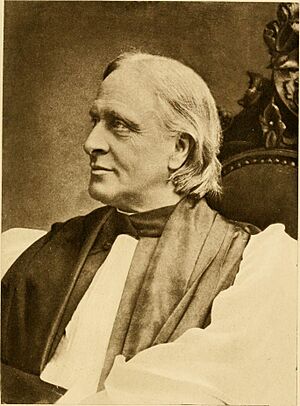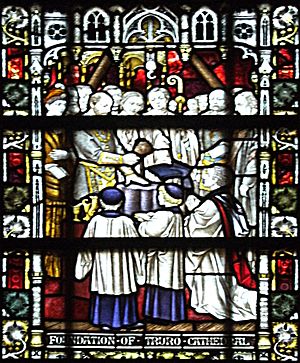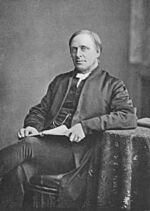Edward White Benson facts for kids
Quick facts for kids The Most Reverend and Right Honourable Edward White Benson |
|
|---|---|
| Archbishop of Canterbury | |

Archbishop Benson, c. 1890s
|
|
| Church | Church of England |
| Diocese | Canterbury |
| Appointed | 21 December 1882 |
| Enthroned | 29 March 1883 |
| Reign ended | 11 October 1896 |
| Predecessor | Archibald Campbell Tait |
| Successor | Frederick Temple |
| Orders | |
| Ordination | 1853 (as deacon) by James Prince Lee 1857 (as priest) |
| Consecration | 25 April 1877 by Archibald Campbell Tait |
| Personal details | |
| Birth name | Edward White Benson |
| Born | 14 July 1829 Birmingham, Warwickshire, England |
| Died | 11 October 1896 (aged 67) Hawarden, Flintshire, Wales |
| Buried | Canterbury Cathedral |
| Denomination | Anglican |
| Parents | Edward White Benson Sr. & Harriet Baker Benson |
| Spouse | Mary (Minnie) Sidgwick |
| Previous post | Bishop of Truro (1877–1883) |
| Education | Trinity College, Cambridge |
| Signature | |
Edward White Benson (born 14 July 1829 – died 11 October 1896) was an important leader in the Church of England. He served as the Archbishop of Canterbury from 1883 until his death. Before this, he was the very first Bishop of Truro from 1877 to 1883. He also started the building of Truro Cathedral.
Earlier in his career, he was a school teacher. He became the first Master of Wellington College in England, serving from 1859 to 1872.
Contents
About His Life
Edward White Benson was born in Highgate, Birmingham, England, on 14 July 1829. He was the oldest of eight children. His father, Edward White Benson senior, was a chemical manufacturer.
He went to King Edward's School, Birmingham and then Trinity College, Cambridge. He finished his studies at Cambridge in 1852.
Investigating Ghost Stories
In 1851, while at Trinity College, Benson and his friend Brooke Foss Westcott started a group. It was called the Cambridge Association for Spiritual Inquiry, but people often called it the Cambridge Ghost Society. This group collected and looked into reports of ghosts. Other famous members included Alfred Barry and Henry Sidgwick. This society is seen as an early version of the Society for Psychical Research, which studies unexplained events.
Interestingly, the famous author Henry James heard a ghost story from Archbishop Benson. This story later inspired James's well-known novella, The Turn of the Screw.
A School Leader
Benson started his career as a school teacher at Rugby School in 1852. He became a deacon in the church in 1853 and a priest in 1857.
In 1859, Prince Albert chose Benson to be the first Master of Wellington College. This school had just been built to honor the Duke of Wellington. Benson played a huge role in making Wellington College a top public school, much like Rugby School.
Church Work in Lincoln and Truro

From 1872 to 1877, Benson was the Chancellor of Lincoln Cathedral. In 1874, he also started Lincoln Theological College, a place for training church leaders.
He was then chosen to be the first Bishop of Truro in Cornwall, serving from 1877 to 1882. He became a bishop on 25 April 1877, at St Paul's Cathedral.
The Diocese of Truro was created in December 1876. Building of Truro Cathedral began in 1880. Benson later officially opened the cathedral on 3 November 1887. He also founded Truro High School for Girls in 1880.
Archbishop of Canterbury
In 1883, Edward Benson was appointed Archbishop of Canterbury. This is the most senior leader in the Church of England.
As Archbishop, Benson helped settle an important church disagreement in 1888. He heard a case about Edward King, the Bishop of Lincoln, who was accused of using certain church rituals. Benson made a judgment that helped guide how these rituals should be performed.
He also worked to bring different church groups closer together. In 1896, he helped them start meeting unofficially as one assembly.
In September 1896, a statement from the Pope questioned the validity of Anglican church orders. Benson began writing a reply to this. He gave his last sermon on 27 September at St Patrick's Cathedral in Ireland.
He became ill on 11 October 1896, while visiting former Prime Minister William Ewart Gladstone in Wales. He passed away from heart failure. His body was taken by train back to London.
Edward Benson was buried in Canterbury Cathedral. His tomb has a special message he chose: Miserere mei Deus Per crucem et passionem tuam libera me Christe, which means "Have mercy on me O Christ our God, Through Thy Cross and Passion, deliver thou me."
A book he wrote about Saint Cyprian, called Cyprian: his life, his times, his work, was published after he died.
His Legacy

Edward Benson is perhaps best known for creating the Festival of Nine Lessons and Carols. This special Christmas Eve service was first held in Truro Cathedral in 1880. A revised version of this service is now broadcast around the world every Christmas from King's College, Cambridge.
As mentioned earlier, Benson told Henry James a simple story about ghosts. James used this idea as the starting point for his famous ghost story, The Turn of the Screw.
The hymn "God Is Working His Purpose Out" was written by Arthur C. Ainger as a tribute to Benson.
In 1914, a boarding house at Wellington College was named "Benson House" in his honor.
Personal Life
Benson married his second cousin, Mary (Minnie) Sidgwick. They had six children together. He also helped raise his younger sister, Ada Benson, who became an orphan.
Many of his children became well-known. His fifth child, Edward Frederic Benson, was a novelist famous for his Mapp and Lucia books. Another son, Arthur Christopher Benson, wrote the words for Elgar's famous song "Land of Hope and Glory". Their youngest child, Robert Hugh Benson, became a priest and wrote many popular novels. Their daughter, Margaret Benson, was an artist, author, and Egyptologist. None of his children married.
Edward Benson's aunt, Mary Ann Jackson, was a talented artist who drew plants.
Works
- Cyprian: his life, his times, his work (published after his death)
Images for kids




